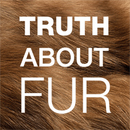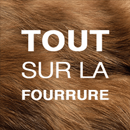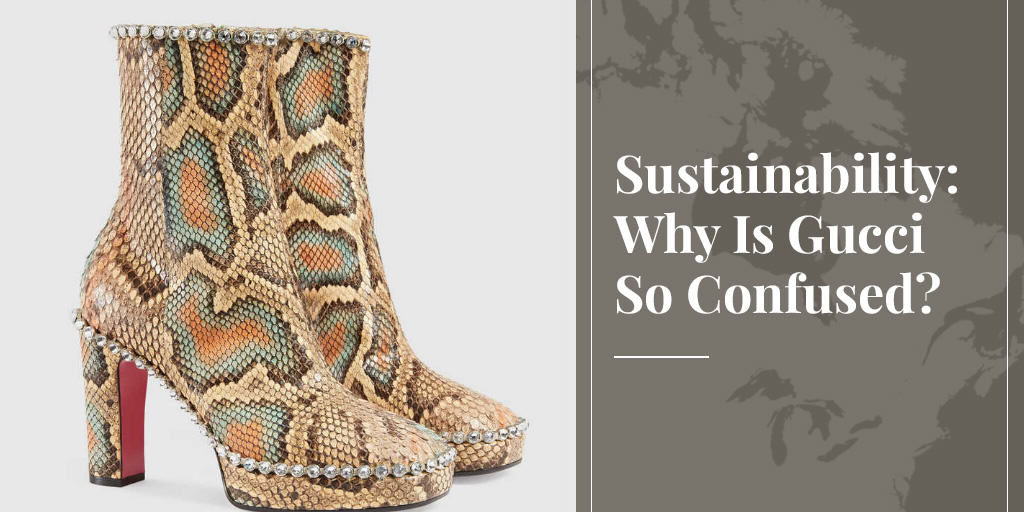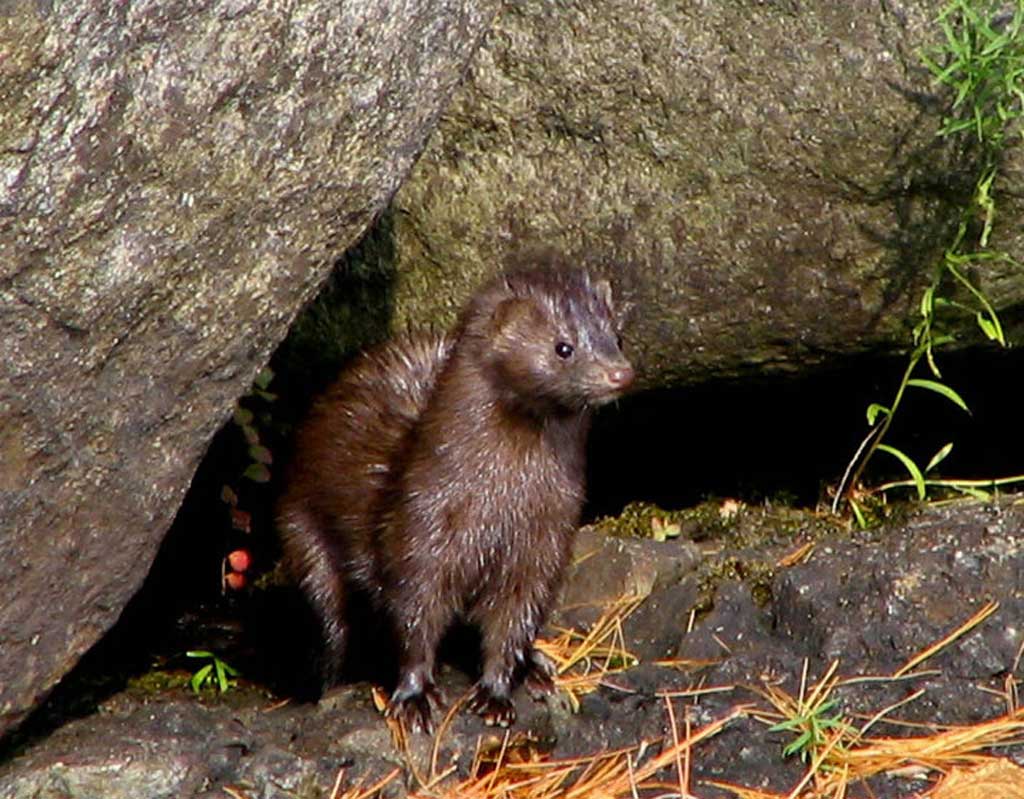In the modern field of conservation, sustainable use is the goal for which resource managers strive. Yet not so long…
Read More

Design & Fashion
Fur Protests: How to Protect Your Retail Business
by Alan Herscovici, Senior Researcher, Truth About FurThe fur retailing season is beginning, and with it we can expect the usual flurry of fur protests. Despite decades…
Read More
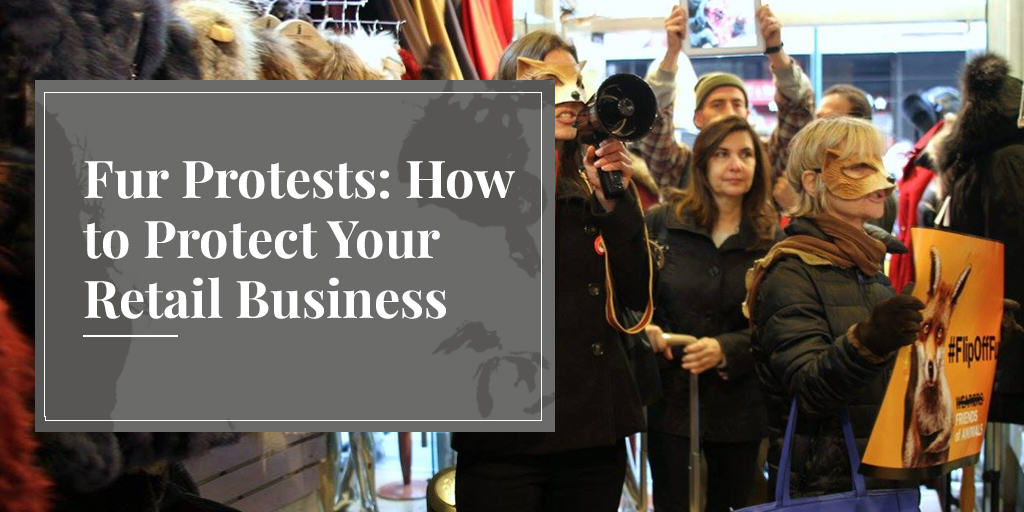
The fur retailing season is beginning, and with it we can expect the usual flurry of fur protests. Despite decades of anti-fur campaigning, activists have generally failed in their efforts to push designers and consumers away from using and wearing nature’s most beautiful clothing material. Fur has probably never been featured in so many top designer runway collections, and fur has certainly never been used in a wider variety of products, from apparel to accessories to home furnishings.
But animal rights activists are not very interested in opinions that differ from their own, so the fur protests continue.
Sometimes, consumers are harassed and retailers are warned that their stores will be targets until they stop selling fur. (Can you spell Protection Racket?) A favourite new tactic is the store invasion (often called Direct Action Everywhere or DxE) where activists enter a shop, individually, posing as consumers, and then pull out posters and begin chanting slogans in unison. One or more protesters film the “action”, taunting shop owners and security staff who dare not push them towards the exit for fear of being slapped with assault charges. Another nasty new trick is to flood a retailer’s Facebook page with negative comments and reviews.
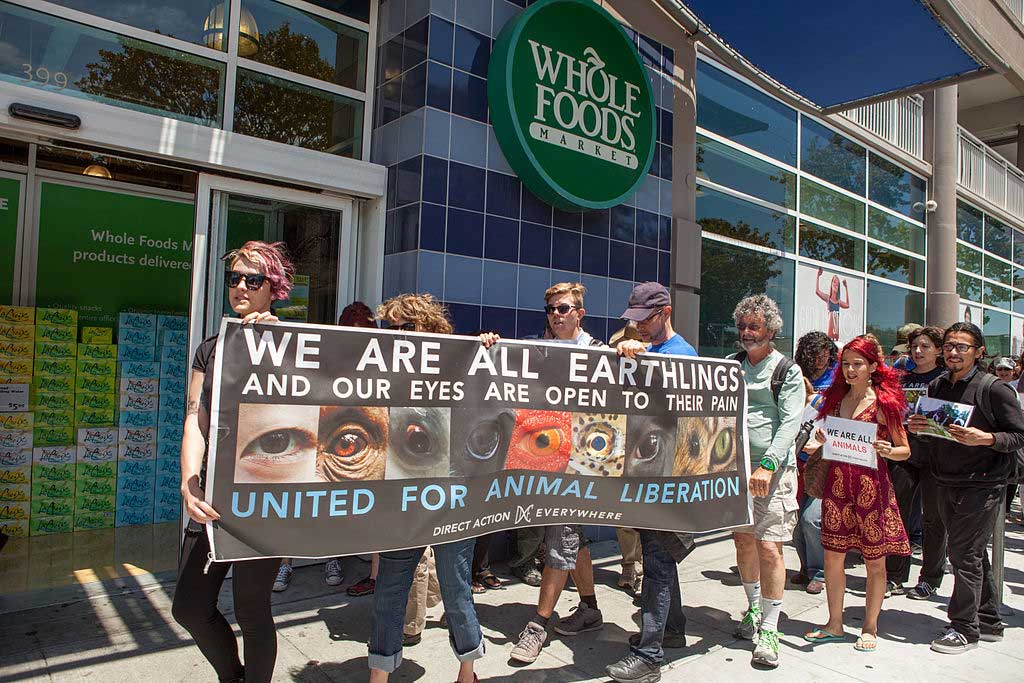
Following are some ways to protect your retail business from animal rights protests.
1. Use Early-Warning Systems
While fur protests can happen any time – especially during the fur season – the next big activist target date is “Fur Free Friday” (the activist response to “Black Friday”), which falls on November 24 this year. Google "Fur Free Friday 2017” to see if your town is listed. Or monitor the national Facebook page.
There are many ways to find out about protests that may be planned for your store. Animal rights groups are often headquartered on university or college campuses, and they find many of their foot soldiers there. So monitor university bulletin boards. It's even better if someone you know can join the local animal-rights group. Or simply keep an eye on the Facebook page of your local animal-rights group.
Not least important, your national fur trade association can provide a timely heads-up when trouble is brewing, or advice and assistance if your store becomes a target. Be sure you are a paid-up member of the Fur Information Council of America (323.782.1700; [email protected]), or the Fur Council of Canada (514-844-1945; [email protected]). They need your support so they can be there to support you!
2. Build Relations with Local Law Enforcement ... and Others
It is always best to build your relationship with local police before you need their help. It can be as simple as calling your local precinct and asking for a meeting with a commanding officer. Or speak with officers who patrol your street. Explain your concern that stores selling fur are often targets for protests or vandalism. Getting to know your local police can play big dividends: they can often warn you of up-coming protests, or keep an eye on your store at night, especially in the period before and after fur protests, a time when vandalism often occurs.

Not least important, police can be present during demos, to tone down rowdy demonstrators and ensure that consumers can access your store without being harassed. While police cannot “take sides”, they do have a mandate to keep the peace and prevent harassment or confrontation, which allows them to keep protesters a certain distance from your door. How they interpret this mandate often depends on what sort of relationship you have developed beforehand.
Remember always to file a police report about any harassment, threats, graffiti or other vandalism, no matter how minor. Take photos before scraping away graffiti from store windows or walls. And keep any threatening phone messages. Such incidents often precede more significant attacks. And these reports allow police to see patterns of radical activism developing, or to make a case with their commanding officers for devoting scarce resources to protecting your store.
You should also build bridges with your local business group or Chamber of Commerce, and with local politicians. Their support can help to ensure that the police will be there when you need them.
3. Secure Your Store
Most fur stores have good security systems to prevent break-ins and theft – insurance companies require them – but be sure you have security cameras and that they are functioning! Cameras surveying the inside of the store can help to identify protesters who enter your premises. Cameras facing the sidewalk can discourage vandalism.

One particularly nasty activist weapon is Butyric acid, a carboxylic acid that has an extremely powerful and unpleasant vomit-like odour. When sprayed under the doors of a store, at night, fur coats can be effectively ruined, as the smell is nearly impossible to remove. The best solution is prevention: ensure that there Is no way to spray anything under your doors or through keyholes or mail slots!
4. Prepare Yourself and Your Staff
Plan and discuss the procedures you will employ if there is a protest at your store. As a general policy, do not engage or argue with protesters; confrontation will only encourage them and could make the protest more "newsworthy" if any media are present. Never touch or push protesters.
Some retailers have rented large cube vans to park in front of their stores, blocking the protesters from the view of passing cars or pedestrians on the opposite sidewalk.
If you know in advance about a protest, consider hiring professional security: they have the knowledge and experience to handle protesters lawfully and effectively.
If you are subjected to repeated or abusive fur protests, you should consult a lawyer: there is a considerable body of labour law relating to the legal limits of picketing.
5. During Fur Protests
It is rare that protesters try to enter stand-alone stores (DxE invasions usually target shops in malls), but if they do, ask them to leave, and call the police. Do not try to expel protesters physically; it is very likely that you are being filmed, and any physical contact could result in criminal charges.
It can be useful to have someone photograph the fur protesters, for identification if needed, and to let them know they are being watched. But check first to ensure that this is legal in your town. And remember rule number one: you do not want to escalate tensions or provoke violence. It is usually better to suffer through the occasional fur protest quietly, rather than make yourself a target for more protests.
For those who would like to respond more actively, the Retail Fur Council of Canada has produced a new tool for retailers to use if they are subjected to a DxE store invasion. Click on the posters below to download, then print them out and hold them up behind chanting protesters or in front of their cameras, or display them in store windows during fur protests. Messages include: “Say NO to extremists” and “Defend freedom of choice!” Such tools should be used with caution, though; you do not want to escalate tensions or make yourself more of a target.
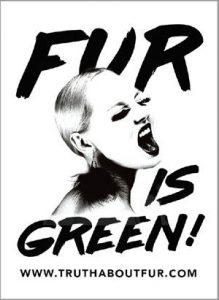
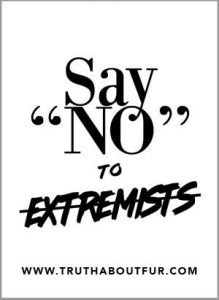
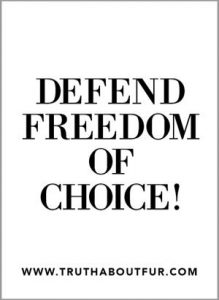
6. Dealing with Media
Media now usually ignore fur protests, especially in larger cities. If journalists do ask you to comment, it is usually best to refer them to your national association (FICA or the FCC). Your association professionals are trained and better prepared to speak with the media ... and they have no street-level store windows to break.
If you do want to say something, keep it simple and positive, and then suggest that the journalist contact your national association for more information.
Here are some examples of the type of media statement you can make:
- “If someone does not want to wear fur or leather, or eat meat, that’s their choice. But most people in our society think we do have a right to use animal products, so long as this is done responsibly -- as fur is. If you want to know more about that, you should speak with our national association; I will give you their coordinates.”
- “Everyone has a right to their opinions, but our business is doing very well. We are very proud to offer our customers high-quality and sustainably-produced natural products like fur. If you want to know more about that ...”
- “If our store is thriving after so many years, it is because there are many people who appreciate the beauty of natural clothing materials. Sure there are synthetic alternatives, but most are made from petroleum, which is not really better for animals or the environment. If you want more information about how fur is produced ..."
7. Dealing with Cyber-Attacks
Several North American retailers have recently been hit with cyber-attacks where their Facebook pages are flooded with negative comments and ratings.

If this happens, here are some things you can do:
- Contact Facebook immediately and ask them to remove the abusive (and fake) ratings/reviews. Go to Facebook's Help Centre here, and follow the menu items Policies and Reporting / Reporting Abuse.
- Tell them this is an orchestrated terrorist-type cyber-attack; tell them you feel threatened.
- If you advertise with Facebook, tell them you will stop advertising if they cannot remove these abusive posts/ratings quickly. (It works!)
- If Facebook does not respond quickly, contact [email protected]; as a stop-gap measure we can rally supporters for positive posts.
- The simplest and quickest solution of all is simply to disable the ratings and comments section of your Facebook page.
Finally, remember: It is always best to be prepared, but most fur protests are brief and relatively harmless. The most important thing is to remain calm and not be suckered into escalating the tension. If you learn that you will be targeted by a fur protest, contact your national association – they have the experience to help you get through these frustrating episodes.
Do you have any other ideas or experiences you would like to share? We would love to hear from you!
Fur-Free Gucci Policy Contradicts Company’s “Sustainability” Claims
by Alan Herscovici, Senior Researcher, Truth About FurGucci CEO Marco Bizzarri puzzled many when he recently announced that the prestigious design label would go “fur-free” in 2018….
Read More
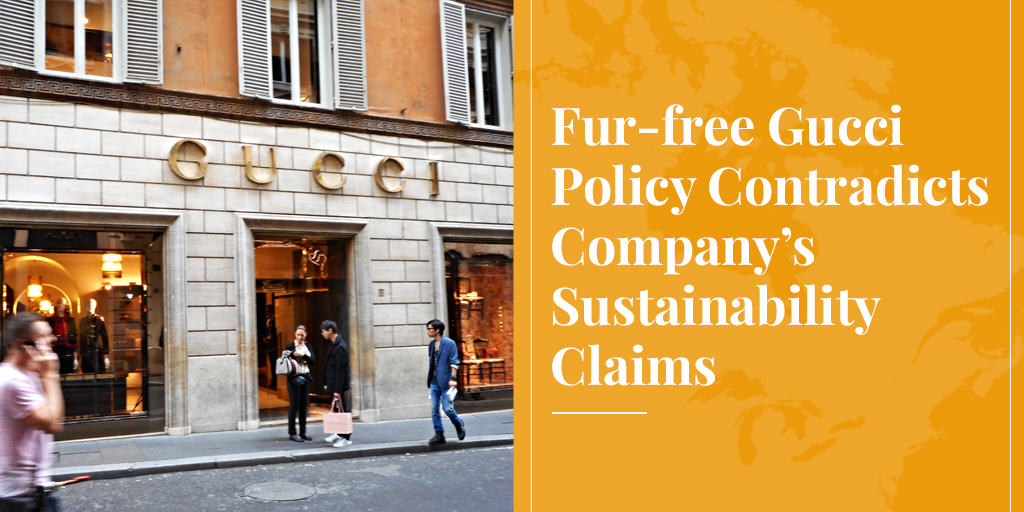
Gucci CEO Marco Bizzarri puzzled many when he recently announced that the prestigious design label would go "fur-free" in 2018. The confusion wasn’t about the decision itself – fashion companies change directions all the time – but about Bizzarri’s claim that a fur-free Gucci was meant to demonstrate "our absolute commitment to making sustainability an intrinsic part of our business."
Mr. Bizzarri’s comments are certainly bizarre, and not only because Gucci was founded and is still known as a leather designer.
His comments are bizarre because, whatever your personal opinions about the ethics of using animals, there is no debate about the fact that the modern fur trade is an excellent example of environmental sustainability.
Perhaps someone should explain to this social-responsibility-climbing CEO what environmental sustainability really means.
Following is a short primer on sustainability and fur.
SEE ALSO: Sustainabiity: Why is Gucci so confused?
Sustainability Primer for Fur-Free Gucci
The concept of sustainable development was launched by the Brundtland Report, from the United Nations World Commission on Environment and Development (WCED), published in book form as Our Common Future, in 1987. As quoted on the corporate responsibility and sustainability page of Gucci’s own website, this landmark document proposed that our environmental challenge is to meet "the needs of the present without compromising the ability of future generations to meet their own needs."
In layman’s terms this means living on the “interest” that nature provides, without depleting our environmental “capital”, i.e., the air, water, and natural ecosystems that we depend upon for our survival. So, whenever possible, we should use renewable resources (plants, animals) rather than non-renewable resources (petroleum-based synthetics). And we should use these renewable resources sustainably, i.e., no faster than nature can replenish the supply.

The sustainable use of renewable natural resources is based on the fact that most species of plants and animals produce more young than their habitat can support to maturity. The ones that don’t make it feed others. And we are part of this natural system. We too can use part of this natural “surplus” for our food, clothing, shelter and other needs.
Let’s see how fur measures up to these sustainability requirements. There are two main types of fur used today: wild-sourced and farm-raised. They have somewhat different implications for sustainability, so we will consider them separately.
Wild-Sourced Furs: Sustainable Use of an Abundant and Renewable Resource
The modern wild-fur trade is an environmental success story. All the fur we use today comes from abundant species, never from endangered species.
Thanks to national and international regulations, fur is an excellent example of the responsible and sustainable use of renewable natural resources.
To ensure that we use only part of the surplus that nature produces (“sustainability”), trapping is strictly regulated in North America by state, provincial and territorial wildlife biologists. Thanks to these regulations, the most important North American furbearers (beaver, muskrat, coyote, fox, raccoon) are as abundant today as they have ever been, or even more abundant. In fact, furbearer populations would have to be controlled in many regions even if we did not use the fur, to prevent the spread of disease or to protect livestock, property, other species or natural habitat.
SEE ALSO: Abundant Furbearers: An Environmental Success Story
And while not strictly a sustainability issue, it is also reassuring to know that North American trappers respect animal welfare. Modern trapping methods have been refined by more than 30 years of scientific research and must comply with the Agreement on International Humane Trapping Standards (in Canada) and Best Practices (in the US).
Wild furs are, in fact, the ultimate free-range, organic and locally sourced clothing material. By contrast, most synthetic materials are made from petroleum, a non-renewable resource.
Not least important: when you buy wild fur you are providing income to First Nations and other people living in rural and remote regions where alternative employment can be hard to find. Helping people remain on the land – where they can monitor industrial activity and sound the alarm when nature is threatened – is also an important sustainability objective.
Farm-Raised Furs: Completing a Sustainable Agricultural Nutrient Cycle
Globally, most fur is now produced on farms, and fur farms also contribute to environmental sustainability in several important ways.
Mink and fox are the most commonly farmed furbearers. They are carnivores, and are fed left-overs from our own food-production – e.g., the parts of cows, chickens, fish and other food animals that we don’t eat.
Farmed fur animals recycle food wastes into a beautiful, long-lasting and ultimately biodegradable clothing material, while their manure, carcasses and soiled straw bedding are used to produce bio-diesel and organic fertilizers, completing the nutrient cycle.
Fur animals are raised on small, family-run farms. And fur farms can thrive in regions where the soil is too poor or the climate too harsh for most other agriculture.
And, again, while not strictly a sustainability issue, it is reassuring to know that fur farmers provide their animals with excellent nutrition and care. Animal welfare is assured by legislation and various codes of practice, but, above all, because excellent nutrition and care are essential to produce high-quality fur.
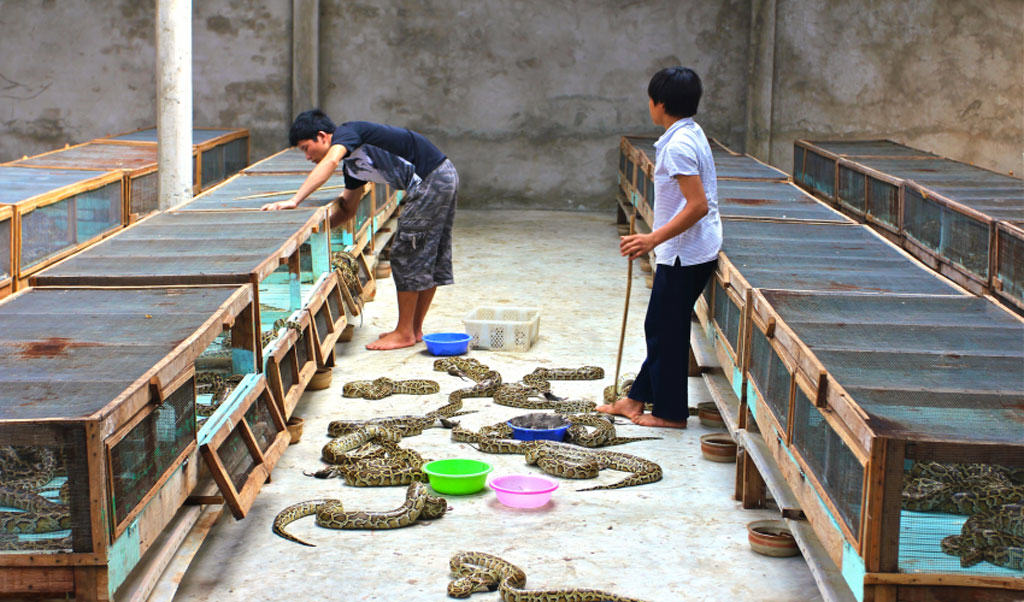
Fur-Free Gucci Is Misguided and Hypocritical
As even this brief summary shows, Gucci’s new fur-free policy completely contradicts its CEO’s claims about "our absolute commitment to making sustainability an intrinsic part of our business."
Bizzarri also justified Gucci’s new policy by claiming that fur is “not modern,” a serious charge in the fashion world. But what could be more modern than using materials that are produced responsibly and sustainably, like fur?
Fur-free Gucci smacks of opportunism and hypocrisy because, as mentioned, Gucci has always been known for its leather products. Someone should tell it that leather is produced by scraping the fur from an animal hide.
Some argue that leather is a by-product of animals raised primarily for food. But some fur animals are also eaten, including various types of farmed sheep and rabbits. Beaver, muskrat and other wild furbearers also provide food for aboriginal and other trappers and their families.
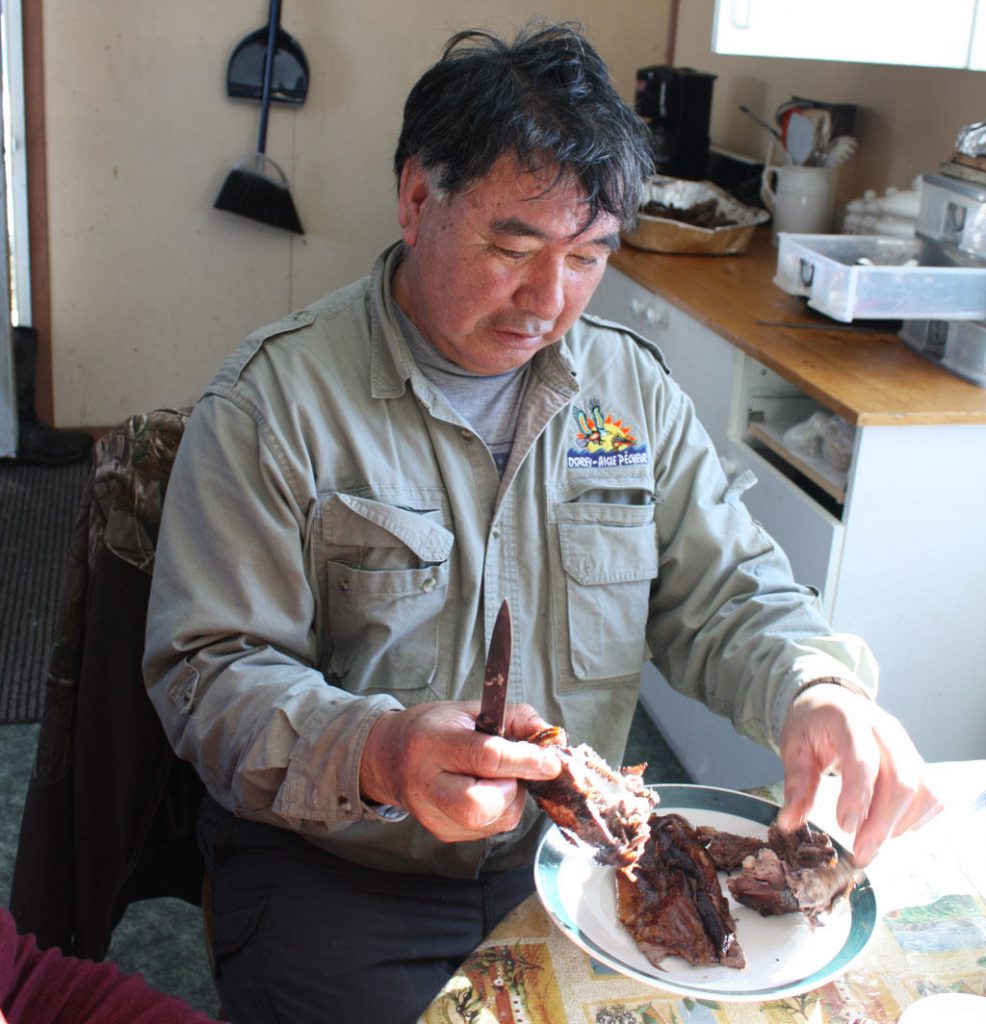
Furthermore, not all leather comes from food animals – notably the python and other exotic leathers used extensively by Gucci. In fact, Gucci’s parent group, Kering, recently bought its own python farm in Thailand to ensure good welfare conditions for the reptiles its members use. If Gucci was concerned about the welfare of fur animals, instead of dropping this beautiful and environmentally sustainable material, surely it would have done better to inspect the fur farms that supply it, or learn about how wild fur production is regulated.
Perhaps the good news in this story is that Gucci's bizarre decision about fur provides an opportunity to begin a more serious public discussion about the real meaning of sustainable living. And companies like Gucci can play an important role in this discussion. But first, it would do well to do its research and review its ill-conceived position on fur.
If you want to tell Gucci what you think of its new fur-free policy, you can contact it here (options vary depending on region, just pick one). Include the URL of this blog post, and recommend viewing of Furbearing Animals: A Renewable Natural Resource, by the Fur Council of Canada.
Or you can email Gucci directly at: [email protected]
Or telephone: 1-877-482-2499.
SEE ALSO:
Does Gucci Really Want to Choke the World with Plastic Fur? By Mark Oaten, CEO, International Fur Federation
Gucci: Ethically Minded or Sadly Mistaken? Things that Make You Go Hmmm. FurInsider.com
Even those of us who think dressing up means jeans and a clean T-shirt have an opinion about “high fashion”….
Read More
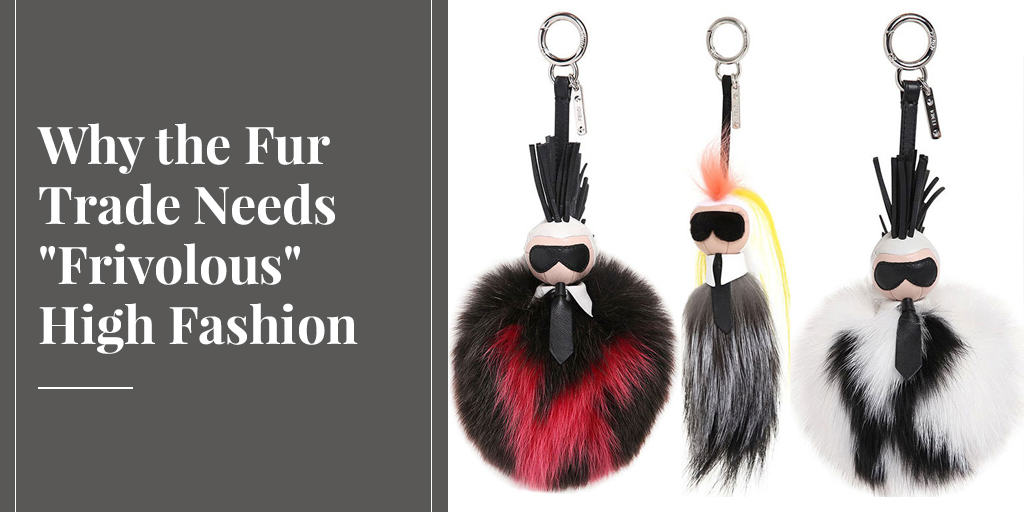
Even those of us who think dressing up means jeans and a clean T-shirt have an opinion about "high fashion". Skinny models in bizarre outfits … we’ve all seen them in old copies of Vogue begrudgingly read in the dentist’s waiting room. And since high fashion loves fur, it can also influence our opinion of fur fashion in general, and not always in a positive way.
That’s right. High fashion, with all its excesses, is a double-edged sword for the fur trade. While those who understand it value its promotion of fur, the jeans-and-T-shirt crowd can be left thinking fur fashion is a lot of frivolous nonsense. Or worse, a waste of animal life.
So for all the fashion heathens among us, let’s learn more about how high fashion works and why it is so important to the fur trade. To this end, I interviewed our resident fashion insider, Alice, who has years of experience working in the luxury fashion sector.
Simon: The public’s view of high fashion, or haute couture, can be rather negative. Designers with exotic names making outlandish outfits for a handful of wealthy clients make it seem elitist and self-indulgent.
Alice: First let’s get our terms straight. Haute couture and high fashion are not the same and have different objectives. Haute couture describes a very small niche of the luxury fashion world, hand-making one-off pieces that only royalty and oil sheiks can afford. High fashion is a loose term for the collections of luxury designer brands that are for sale to the general public and influence trends in mass-market fashion.
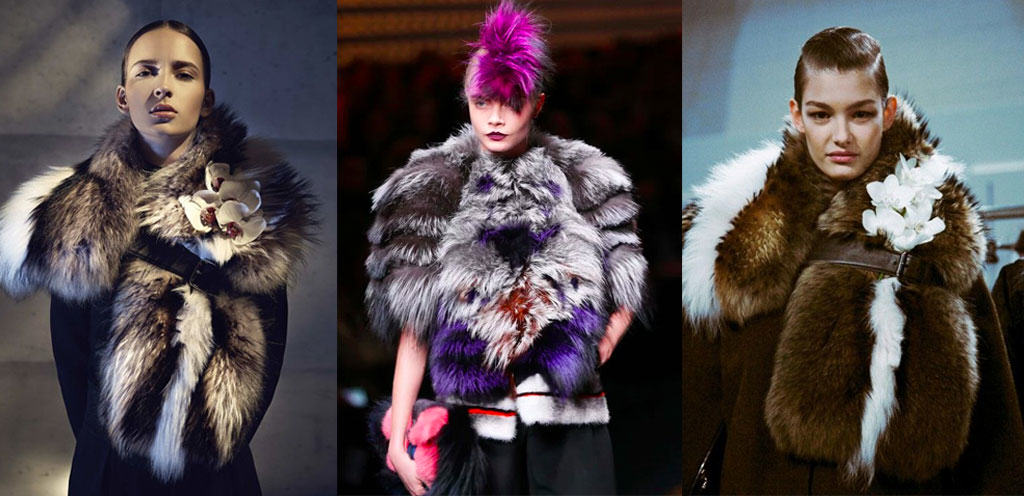
Simon: Whatever they’re called, some of their pieces are so weird, no normal person could carry them off, so why bother?
Alice: If pieces look unwearable, it’s probably because they’re not meant to be worn. But they have a definite purpose; they represent the big ideas of a collection. These ideas are then tapered down into more normal items for the stores of the designer brands. Fast-fashion and mass-market brands then make them even more commercial and sell them on the high street.
So while a designer-brand show may feature an insane, brightly coloured fur coat with feathers and all kinds of things sticking out of it, its stores may not even have that coat. It might have a production run in single digits, with less volume and no feathers. Then a high-street store will make a bolero jacket with the same colours but fake fur. It gets massively tapered down.
And sometimes catwalk pieces aren’t for sale at all. These are called “press pieces”. Again, they represent the big ideas, but they look super spectacular because their purpose is to make the pages of magazines. So a stylist might look at a collection of sheared mink jackets decorated with beaded flowers, and then ask the atelier to make a mink bikini top and matching headband, covered in beaded flowers, and pair it all with a long skirt with a train. No one would ever go to the beach dressed like that, but it makes an impact on the catwalk.
Are Buyers of High Fashion Different?
Simon: When I need a new pair of cargo shorts, I don’t check Vogue first. I just head to the store and buy the first pair that fits. Are buyers of fur fashion so different?
Alice: Yes. Fur fashion is part of the luxury sector, and buyers of any luxury goods, not just fur, behave differently from buyers of $10 cargo shorts.
Most people with $10,000 and more to spend on a fur coat don’t just walk into a store and pick one they like. A seed has already been planted in their mind of what they want, and designer brands plant these seeds by having their clothes on the catwalk and being worn by celebrities and other influencers.
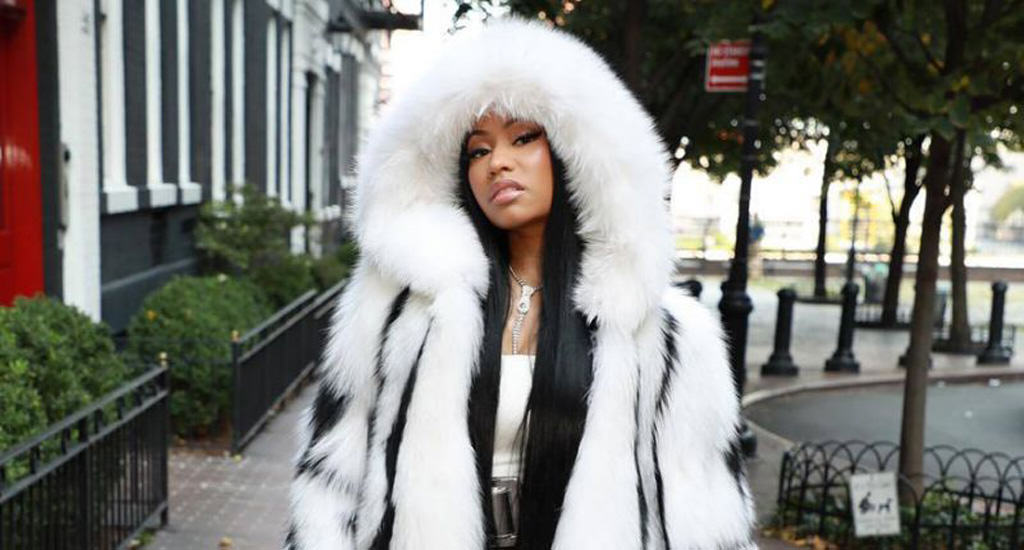
And when that happens, it’s very important for furriers and fur manufacturers to be on trend. At the last New York Fashion Week, rapper and style icon Nicki Minaj got a lot of media coverage in a $19,000 Oscar de la Renta fox coat. It’s likely that this style of coat is going to be popular at retail now, and the furriers may have even placed rush orders to get similar coats in stock. “Trickle down” would also see cheaper, less-flashy versions in fast-fashion outlets, maybe even made of fake fur.
Simon: Trickle down?
Alice: Yes, trickle down theory is when a designer brand sets a trend, and others follow suit with more affordable versions. There’s also “trickle up”, like if designer brands are inspired by street style or subcultures, like punk or hip hop. But for luxury goods like fur, trickle down is key.
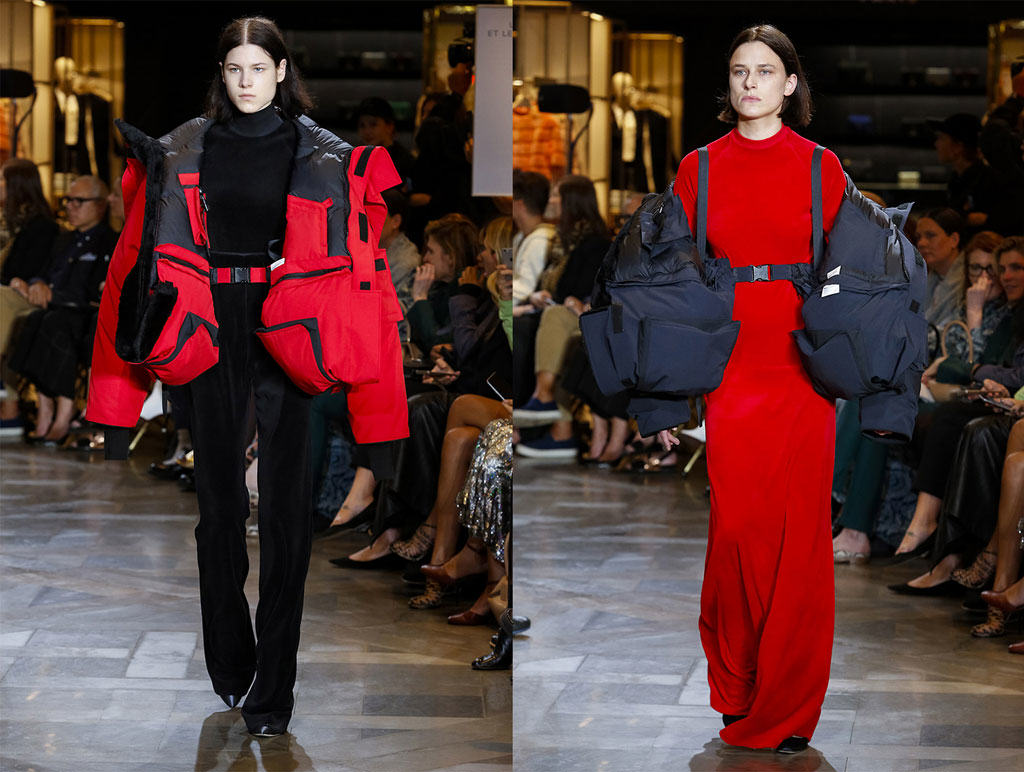
Simon: So how far down does it trickle? Surely Canada Goose, known for its functional coyote-lined parkas, doesn’t care what designer brands are doing.
Alice: It certainly does. Canada Goose is known as a performance brand, but it’s already collaborated with French designer brand Vêtements, and I expect it to be influenced more and more by high fashion in the next few years. It gives Canada Goose credibility – a “cool factor” – to be associated with a designer brand, rather than just being known for functional parkas. And it will sell more of the regular coats just because it happens to have a couple of fashion-forward ones available.
A better example of these collaborations is H&M. While it’s known for its fast-fashion, it’s had huge success collaborating with a string of designer brands and celebrities.
SEE ALSO: 5 Reasons Why PETA Won't Make Me Ditch My Canada Goose
Simon: Critics of fur fashion say it’s “frivolous”, and of course they’re not referring to raccoon hats in Winnipeg in winter. They say that when fur is used for purposes other than keeping the wearer warm, the taking of animal lives cannot be justified. A real need must be met, and fur sandals don’t meet the standard. Even some trappers feel this way. They lament that they work hard all winter so someone can wear a pink fur bikini with pom-poms on.
Alice: That sounds like a great argument; no one wants to see animals being killed for no good reason. But where the fur trade’s concerned, it doesn’t stand up to scrutiny.
Furbearers are farmed and trapped above all to make cold-weather clothing, and if this clothing also happens to be fashionable, it does not lessen the fact that its primary purpose is to keep people warm. As for accessories, you must remember that animals are not killed for the purpose of making these. The vast majority of fur pelts, and certainly of prime pelts, are made into coats, and accessories are made from whatever's left. This includes scraps, parts like tails that are normally only used for trim, and the good parts of damaged or low-quality pelts.
A friend of mine once won a set of mink golf club covers in a raffle and, curious to know how much they were worth, asked around. It turned out they were very affordable because they were made from the pelts of farmed mink that died naturally before their fur had fully grown. He was a little disappointed, but also comforted to know that mink were not being raised for the express purpose of keeping golf clubs “warm”!
So accessories are very much secondary products to cold-weather clothing, and should actually be seen in a positive light because they demonstrate the industry’s dislike of waste.
SEE ALSO: Why Fur Is the Ethical Fashion Choice
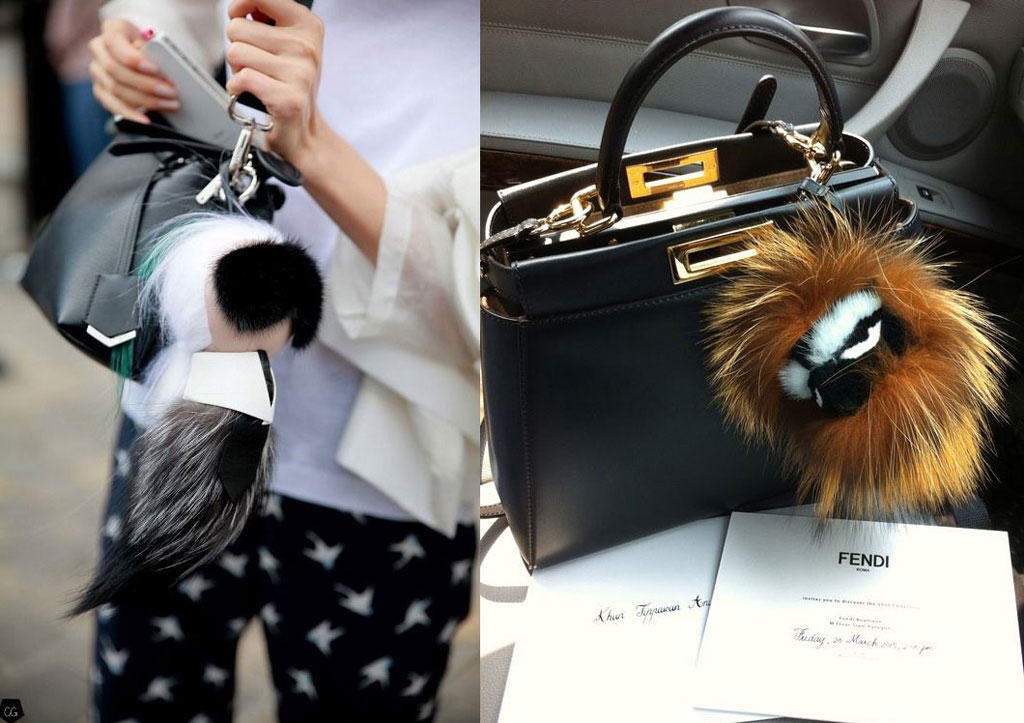
Simon: Still, some stuff is perceived badly by some people, especially the silly stuff like furry bag charms or covers for iPhones. The fur trade seems to be courting criticism for appearing insensitive to the fact that animals have died, while producing items that don’t even help their core business.
Alice: What you call “silly” stuff, marketers call “fun” stuff, and they exist in all areas of retailing. And you’re mistaken if you think they don’t help the core business. It’s a proven marketing strategy that by offering fun items at low prices – entry-level items – more people will end up buying the high-end product you really want to sell. So if a girl buys a furry key-ring bauble and ear rings and all her friends think they’re awesome, then her next step might be to buy a fur scarf. And when she grows up, her attraction to fur may translate into a full-length coat.
Small, affordable items also generate exposure to friends of people who buy them, and open up debate about your product. Those iPhone covers, for example, have had an amazing amount of media coverage, all positive.
So if turning a small percentage of pelts into cute accessories opens up the dialogue about fur, makes it more accessible, and gets more people to wear fur, it makes perfect business sense to do it.
And as I’ve already said, animals are not killed for the purpose of making accessories. If anything could be said to show disrespect for animal lives it would be throwing the fur scraps away. Instead, they are used to create fun items that give people pleasure. There’s nothing wrong with that.
High Fashion Influences Us All
Simon: So to sum up, how important is high fashion to the fur trade?
Alice: Extremely important. While fur is on the catwalks, it continues to be a fashion item and is in demand in the fashion market. Without the fashion component, we will see many more "practical" fur pieces, such as parkas and more simple coats whose sole purpose is warmth, but less of the stylish pieces.
It’s vital that fur fashion appears in the media and that is achieved by putting it on the catwalk and on the backs of celebrities. No one is better at doing this than designer brands, and they also have the money to pay for advertising.
But remember that high fashion influences every sector of the fashion industry, not just the luxury sector. Any company involved in designing, producing or marketing clothing is constantly alert to what direction the market is taking. They follow current trends but also hope to predict future trends, and for this they look to designer brands, fashion media and celebrities.
So as consumers, we might think that high fashion is irrelevant to us and that we make independent decisions about what to wear. But that’s rarely the case. We are all subject to being influenced, and though we may not know it, high fashion influences what every one of us wears.
A few weeks ago, online retailer group Yoox Net-A-Porter made headlines for all the wrong reasons. The group’s websites –…
Read More
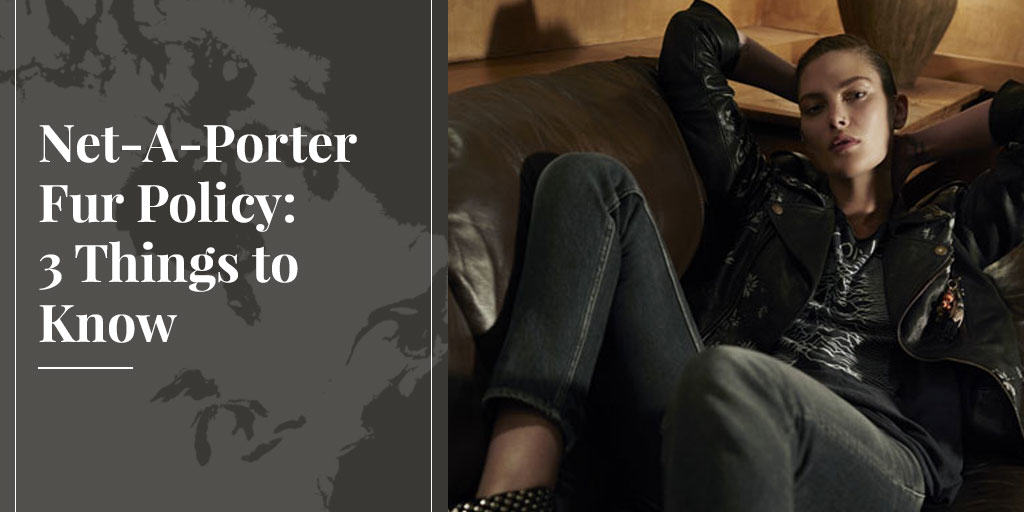
A few weeks ago, online retailer group Yoox Net-A-Porter made headlines for all the wrong reasons. The group’s websites – including Net-A-Porter (a leading luxury retail platform) – announced that they would not include fur in their offerings. Here are three things you need to know about the Yoox Net-A-Porter fur policy.
1. This Is Not News
The Net-A-Porter fur policy has been in effect for years, and its sister websites, Mr Porter and The Outnet, have also not sold fur for years. Net-A-Porter also doesn't want its staff wearing fur at work-related events, though we couldn’t help but notice that its editor-in-chief, Lucy Yeomans, was praising her fur-trimmed Canada Goose jacket on Instagram not long ago. So while its poorly-informed fur policy is certainly disappointing, it is not news.

2. It's Hypocritical
These websites do a huge business in accessories, notably bags and shoes. And guess what most bags and shoes are made of? Whether it’s leather, suede, lizard, snakeskin, or calfskin, these websites have no shortage of animal products.
While this isn't the first “fur-free” company to sell animal products, it’s still misinformed and hypocritical. There’s no rational reason why anyone would stop selling fur and continue to sell leather, suede, shearling, and other animal skins ... and silk, made from larvae that have been boiled alive.
If your company mandate has to do with animal welfare, then it would make sense to limit your offering to materials produced with high animal-welfare standards – and there would be plenty of fur that could meet that criterion. But the Net-A-Porter fur policy in its current form is completely misinformed and utterly hypocritical.

3. The Reasoning Is Nonsensical
Just like each of us has a right to wear or not wear fur, stores have the right to sell or not to sell it. They aren't even obliged to give a reason for such decisions. But if they do decide to explain, would it be too much to ask them to give a logical reason?
Yoox Net-A-Porter's official statement said that they "remain more focused than ever on our commitment to create a sustainable future." But avoiding a natural, renewable material that is produced responsibly and sustainably cannot logically be part of a sustainability initiative. The use of the word "sustainability" to explain this policy is absolutely absurd. The very definition of sustainability is "avoidance of the depletion of natural resources in order to maintain an ecological balance," which would mean that materials from renewable resources, such as fur, leather, and suede, could and should be central to such a policy.
Meanwhile, Net-A-Porter continues to sell fake fur, polyester, and other synthetic materials, all of which are petroleum-based and neither renewable nor sustainable at all.
SEE ALSO: THE GREAT FUR BURIAL: HOW FUR BIODEGRADES AFTER ONE YEAR
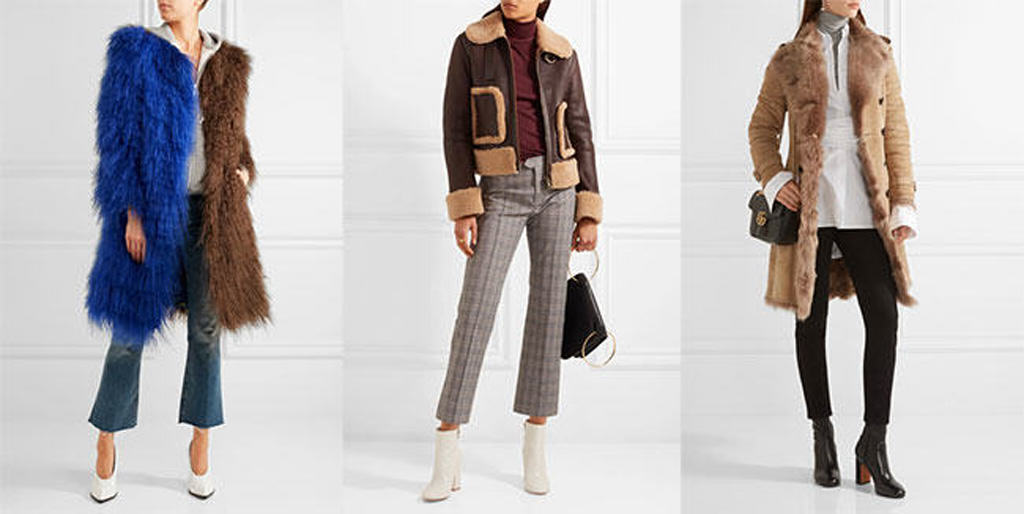
We respect any retailer's freedom of choice and we have seen hypocrisy and misinformation about fur before. But we do expect a large and respected organization such as Yoox Net-A-Porter to base its business decisions on accurate information and responsible choices.
Storing Fur: How to Care for Your Furs During Off-Season
by Truth About Fur, voice of the North American fur tradeSpring is the time to put away your furs, and correct storage during the off-season is essential if you want…
Read More
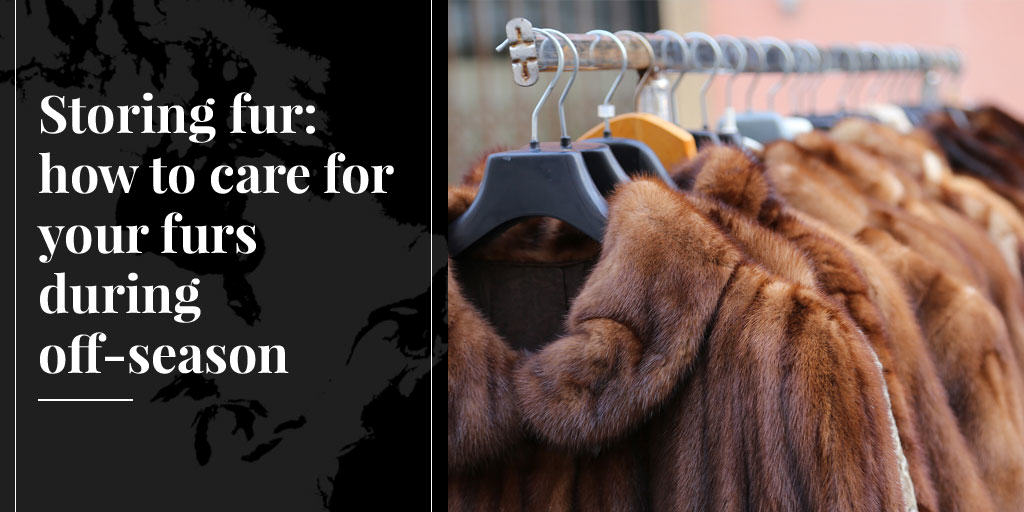
Spring is the time to put away your furs, and correct storage during the off-season is essential if you want to enjoy the warmth, comfort and beauty of your furs for many years. Storing fur coats and jackets is usually best done with a professional retail furrier, although there may be occasions when you want to store some items at home. (More on this below.)
If you own valuable furs (valuable financially or sentimentally), you should definitely store them professionally during the summer months. A good furrier will have a storage facility which is kept in a range of 50-60F (10-15C) and 45-55% humidity, which has been shown to be the ideal conditions for preserving furs. Most people store their furs through the summer months, and bring them home when the cooler weather returns in the fall.
Another reason for storing fur with a professional is that it provides an opportunity for your retail furrier to thoroughly inspect your fur at the end of the season. Small tears, missing buttons, worn spots or other damage can then be identified and repaired before they become bigger and more costly problems.
Your retail furrier is also equipped to properly clean your fur, removing oils (e.g., around the neckline) and small particles of dirt or grit that can damage fur follicles. Professional cleaning also restores the natural brilliance and beauty of your furs.
Just like you would service a car, maintain a house, or correctly clean and store silverware, caring for your furs will protect your investment and assure many more years of use.
Fur storage costs are usually based on the value of your garments. So storing a coat valued at $500 may cost as little as $32 (or $39, including a year-round insurance policy). At the higher end, a $4,500 coat might cost $86 for storage (or $133 including year-round insurance) – i.e., about the price of one decent cup of coffee per week. [Storage prices vary depending on rent and other costs in different regions.]
But what if you have vintage pieces that aren’t in top-notch condition, or other inexpensive garments, trims or accessories? Or maybe there’s no furrier in your area? Is it possible to keep your furs in reasonably good condition at home?

Unfortunately, it is near impossible to duplicate the controlled atmosphere of a professional fur-storage vault in your home closet. But here are a few tips to help protect your furs as well as possible in a home environment:
• Avoid storing fur in a basement, where it can be too damp. Too much humidity can result in a moldy lining.
• Ideally you want to store the furs in a place where there is no direct sunlight, and not too much heat. A bedroom is often a good choice, providing you don’t keep yours too warm.
• The furs need to hang freely and have a bit of air, so don’t try to stuff too many in a closet.
• Use a proper fur hanger, with shoulders, to preserve the shape of your coat.
• If you don’t use your furs frequently, or during the summer months, cover them with cotton garment bags or cotton sheets.
• Never store your furs in plastic; fur needs to “breathe”.
• Removable fur parka trims, scarves, or other accessories can be stored on hangers or in uncovered boxes in your closet.
Heritage Fur Products to Warm the Body and Soul
by Brenda Dragon, President of Aurora Heat, Inc., from Canada's NorthSometimes a particular aroma can bring back vivid childhood memories leaving you awash in feelings of love, comfort, and belonging….
Read More
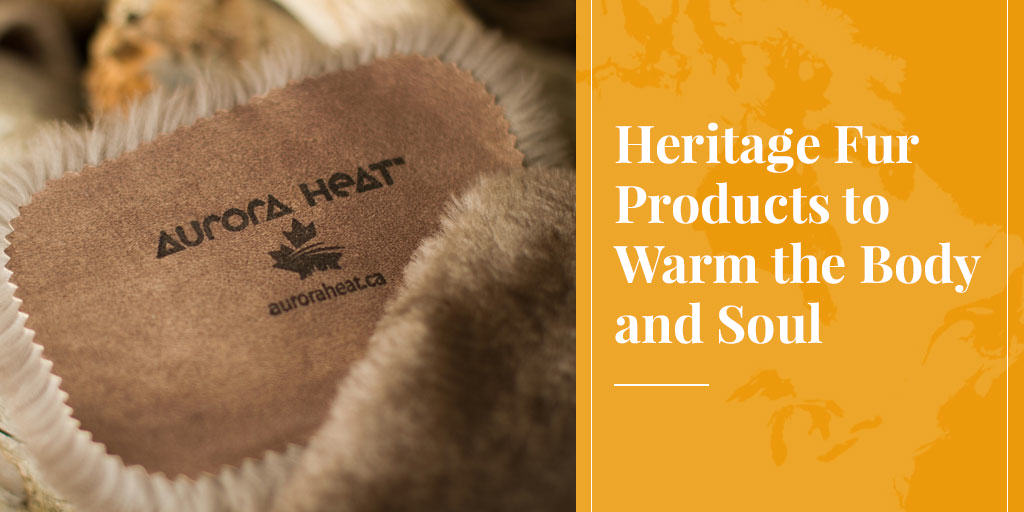
Sometimes a particular aroma can bring back vivid childhood memories leaving you awash in feelings of love, comfort, and belonging. It may be cinnamon buns or fresh laundry for some. For me it is the smells of hides and fur. Wild fur is a part of my family heritage.
My father came from a line of French Canadians who trapped fur bearers in northern Alberta, including the beavers and muskrats of the Athabasca Delta. At 19, he moved to Fort Smith, Northwest Territories and continued to trap on the Alberta side of the border. At the age of 23, he married my mother, who shared his life for 56 years – his perfect match.
My mother is a Chipewyan Dene from Northern Saskatchewan. She moved to Fort Smith as a young teenager. Having left her home community early, she’d had little opportunity to learn the traditional skills of her people. As the young wife of a trapper, she instinctively turned to the elders of her new community for their knowledge and experience. Chipewyan was the language spoken, and I remember their happy faces and the sounds of laughter when it was my job to bring tea as they worked preparing meat, or skinning and fleshing beaver and muskrat.

When my father’s trapping partner was forced to retire because of health problems, I remember being proud of my mother when she convinced my dad that she was the one who should take up the job. She was excited and eager, and I still remember her delight in making a very special lynx-fur hat – a hat befitting a lady trapper.
It was the trapper’s way of life that defined my parents. It gave them an intimate connection with the natural world. They were hard-working people. After a long day on the trap-line, my father would head downstairs to tend to the raw furs while mom sewed late into the evening. She became a well-respected and expert sewer of fur and hides. My parents kept our large family well fed with healthy wild meat and dressed in the warmest of furs. The six “little Dragons” were northern kids who didn’t know the meaning of cold!
They often shared colourful stories about their days together on the trap-line, like the times the wolves out-smarted them, or the afternoon dad went out for a couple hours and came back with four beautiful lynx. The trap-line always brought new adventures for more stories. My parents were also keenly aware of the health and numbers of animals in their territory, and they managed these populations much as a rancher would.
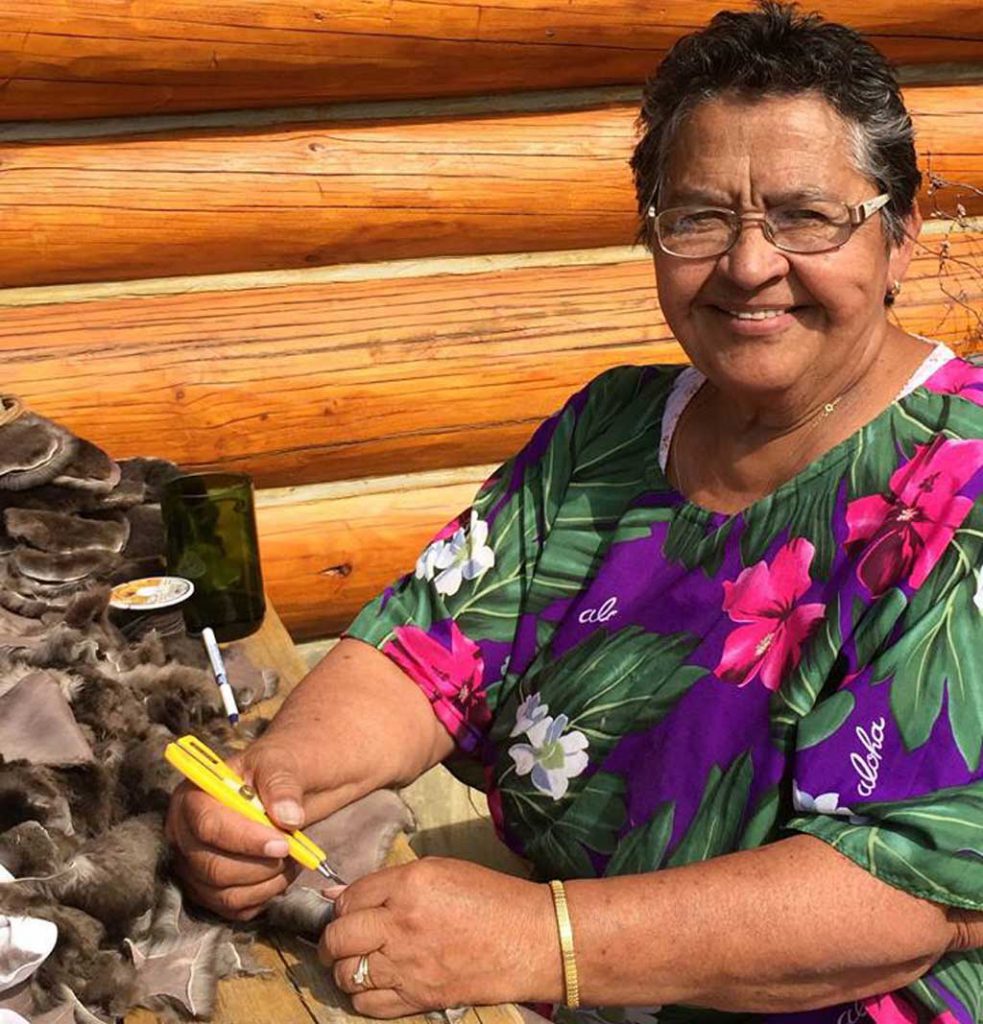
When my father passed away a few years ago, I thought a lot about my parents' remarkable life together, the trap-line, and the barrels of fur he left behind that my mom continues to sew with to this day. I wished for a way to carry on the family tradition.
It was about this time that I moved back to the North. My son, Joel, who had been enjoying snowboarding in the mountains of British Columbia, was now outside every day in -40 weather. I was continually adding fur to the inside of clothing, for both him and his buddies, as my mother had done for us. I was reminded of how effective an insulator fur is as I watched them out in the frigid temperatures for hours. I soon found myself cutting little pieces of fur into squares and gifting them to friends as hand-warmers they could slip inside their mitts.
My ah-ha moment came when, after a while, those cozy warmers had my friends asking for more. I realized that this gift from nature could be shared with more people. Not knowing anything about business or developing a retail product, I began taking steps into that world. I chose sheared beaver primarily from the Genuine Mackenzie Valley Fur Program and went on to develop branding, packaging, and marketing strategies.
Encouragement and sage advice came from my mother, as well as from those who purchased and loved those first Aurora Heat™ hand and foot warmers. Soon I began to hear from people with circulatory problems and arthritis about how my fur warmers were making a difference for them. We celebrated the first anniversary of Aurora Heat in March, and it is now available on-line and in stores across the North and beyond.

Am I excited? You bet I am! I love everything about my new fur business. I love continuing my family heritage and traditions, sharing my mother’s Indigenous culture and ancestral knowledge of thousands of years, and celebrating my parents’ love of the land. I love that I am part of a way of life that continues to thrive in Canada with our cold winters and open-minded people.
I especially love being part of the societal awakening of our need for natural and sustainable products. I love the beauty and the usefulness of fur. There is something about having a piece of nature in your mitten, socks or pocket that is incredibly grounding. We can’t all afford a beautiful fur coat, but anyone can own a pair of reusable, all-natural fur hand or foot warmers to keep fingers and toes toasty-warm year after year.
My vision for Aurora Heat is to offer more people an opportunity to experience the warmth and comfort of natural fur, and look forward to developing more products. I truly believe that if we rely more on nature for our needs, we will come closer to living in harmony with this earth. And, I know my father would have just the biggest grin!
May the fur be with you!
***
SEE ALSO: Hudson's Bay Company stocks Fort Smith line of fur hand warmers. CBC News, March 9, 2019.
Visit Aurora Heat's website or follow it on Facebook. Email Brenda at [email protected].
Have you ever wondered how to recycle old fur? Remodelling is a great way to breathe new life into an old…
Read More
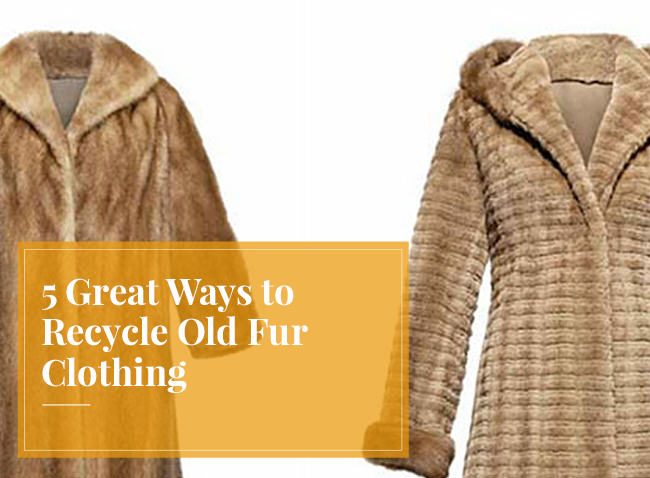
Have you ever wondered how to recycle old fur? Remodelling is a great way to breathe new life into an old fur coat or jacket. Whether it is an old mink coat in pristine condition, or a vintage piece that has seen better days, most furs can be recycled in some way. Just see these before-and-after photos (above) of a coat remodelled by Natural Furs of Montreal.
Here are five things you can do with an old fur coat or jacket.
Recut into a New Shape
This could be something simple like shortening the coat to make it more modern, changing the sleeve shape or just taking off the sleeves to make a vest. Alternatively, you could attempt something a bit more dramatic, like recutting the piece entirely. Fur is unique in that a good coat can be completely transformed into something new using the "letting out" sewing technique that is exclusive to fur. Expect to pay $500 and up for a job like this, and make sure you choose a furrier who is experienced in remodelling and knows how to recycle old fur.
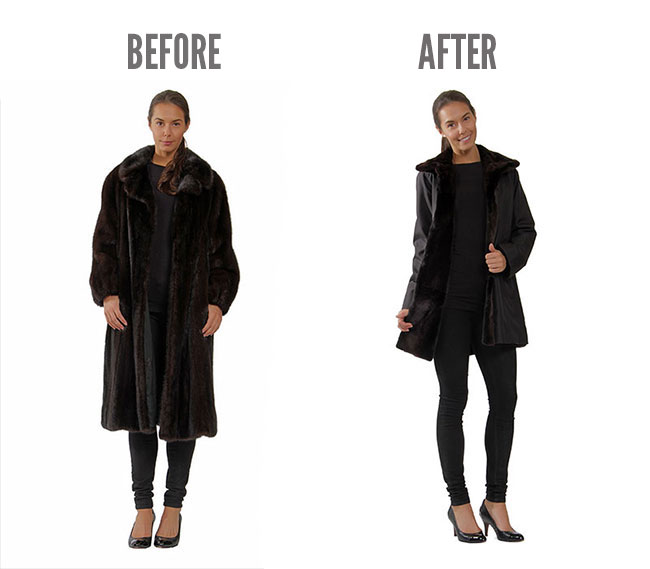
Make an Accessory
An old fur coat could make a great fur collar, scarf, or hat. We've also been told of someone who had an old fur turned into glove liners. My hands are warm just thinking about it. Depending on the complexity of a job like this, you are likely looking at $100 and up.
A Coat Lining
Furs look great on the outside but they also feel really good when they are inside a coat. Creating a coat lining with an old fur coat can be a great way to keep warm without showing off the pelts. This works especially well in rainy places; creating a raincoat lining out of an old fur coat means you will be warm and dry. You might be able to get a lining created for a few hundred dollars, but it will most likely cost over $500 if you are planning to recut the shape and do fancy finishings. This could be a DIY project if you have a coat that you aren't too precious about. Simply cutting off the sleeves, removing the lining, and turning the coat inside out could get you a pretty decent raincoat lining if you don't need something fancy. (I am going to try this over the weekend. Wish me luck!)
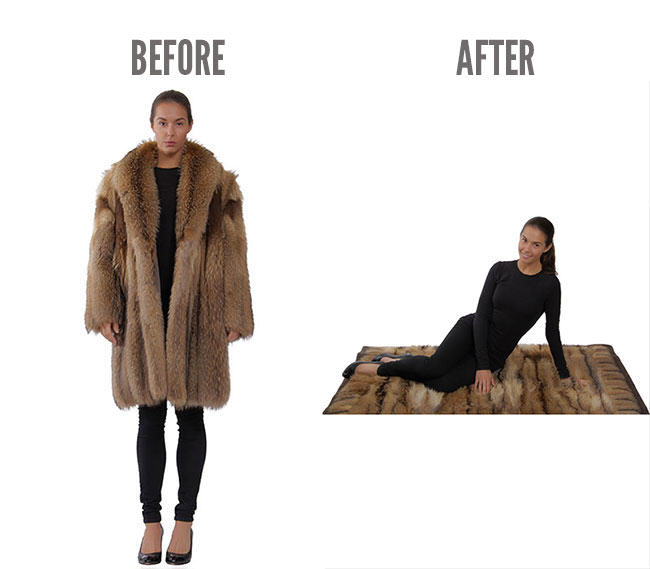
A Cushion, Blanket, or Seat Covering
This is normally what people suggest as a worst-case scenario. If your coat's skins are too dry to be turned into another garment, then making them into a cushion or blanket is a great alternative. Fur seat covers in your car would pretty much be the definition of "driving in style", and if you've got a baby with expensive tastes, you could try to recycle old fur into a baby blanket or stroller lining. My son had an old piece of beaver as the lining of his car seat and he was quite pleased!
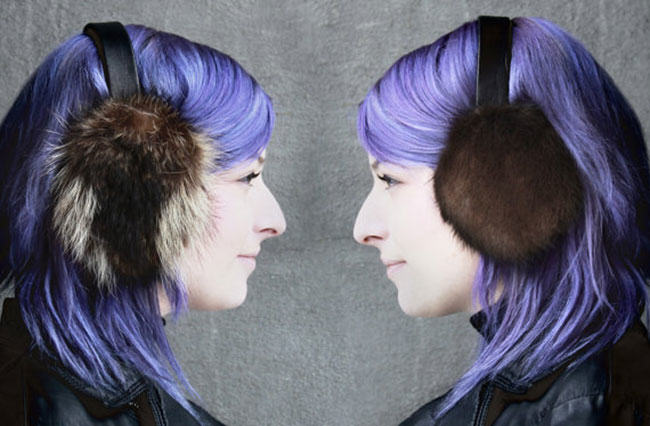
Trinkets
If your coat is too old to turn into a garment, and too small to turn into a cushion or blanket, then you could try making a trinket with it. A fur corsage, piece of jewelry, or a teddy bear is a great way to use an otherwise un-usable piece of fur. This is also a great option for any left over pieces, if you decide to shorten a fur coat, for example, why not make use of the pieces that were cut off?
A few things to consider before recycling a fur:
The age of the garment matters. It needs to have been well taken care of and stored properly in order for the fur to be in good enough shape to be remodelled. A lesson for us all - proper fur coat storage does prolong its life!
Some new pelts are over dried to make them lighter. These ones may also not be idea for remodelling.
Coats that have been let out can sometimes be too weak for remodelling, but nothing is stopping you turning them into a nice throw.
Mink, beaver, and fox are great fur types for recycling, whereas chinchilla, weasel and muskrat have thin leather and are more difficult to recycle into garments.
Remodelling isn't just about cutting a new garment or item from an old fur, you can also dye furs or shear them. There is a world of possibilities!
Clothes moths don’t kill or bite, and aren’t poisonous, but they are the little jerks of the insect world and have very…
Read More
Clothes moths don't kill or bite, and aren't poisonous, but they are the little jerks of the insect world and have very expensive taste. They love furs, cashmere, wool, and any other expensive animal fibers you have in your closet. When it comes to fashion, they are bug enemy number one, but there are ways to keep the little buggers away from your furs, and I'm here to tell you how.
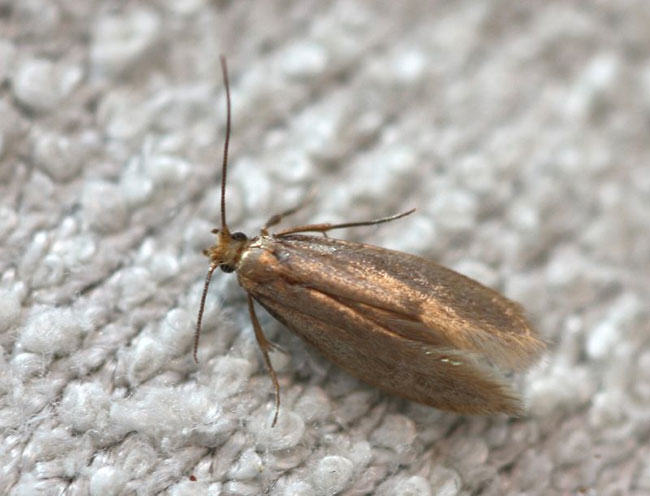
Prevention Is Best
Here are my favourite tricks to turn your closet into a no-go zone for clothes moths.
Cedarwood oil: Spray cedarwood oil (diluted with distilled water) around your closet, but away from the clothes, or place cedarwood oil-soaked cotton balls in corners of closets and drawers.
Lavender oil: Fresh lavender oil (used in the same way as above) is another nice-smelling clothes moth deterrent.
Give them space: Don't over-stuff your closets and give your coats a good shake every now and then. That makes it difficult for clothes moths to get comfortable in there.
Natural repellents: There are quite a few good natural moth repellants on the market, including ones you can hang in between your coats or stuff into the coat pockets. I avoid mothballs, though. They smell bad and are terrible for the environment.
Freezing: Note this is of no use on furs as it will destroy the leather, but I will share my trick for keeping wool and cashmere safe from clothes moths: freeze them for 48 hours in September or October. This kills the eggs, and it is actually the larvae that hatch from the eggs that are responsible for the holes in your clothing, not the clothes moths themselves.
Professional storage: Your best bet for keeping furs safe out of season or when they aren't being worn is professional fur storage. If you are looking for storage near you, ask your local furrier. If they don't offer storage, they will be able to recommend someone who can.
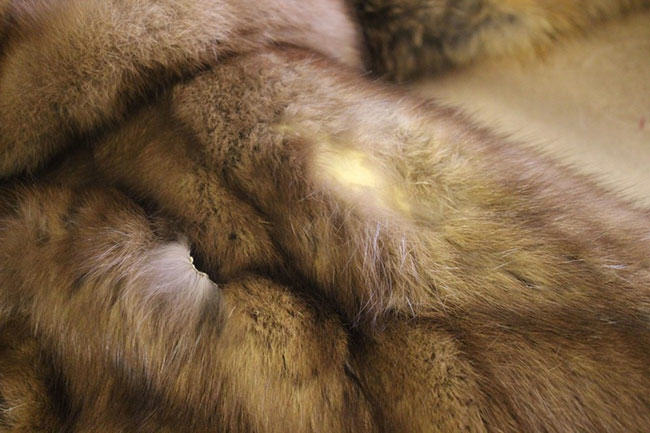
How to Tell If You Have Clothes Moths
A sign of clothes moths is if the fur is shedding. The hairs come loose from the leather, and fall out. But don’t confuse shedding with breakage. Delicate furs, like rabbit and chinchilla, are prone to breakage with heavy wear so it is normal that they break and shed a little bit. But if the hair is coming out in clumps, then you probably have moths.
... And If You Have
Isolate the infested garment. The bad news is, the moths are probably in your other clothes as well so it's time for a full closet clear out. Fumigation is one solution, but you can also clean and/or kill the moths on your clothes by washing and/or freezing everything, and then cleaning the entire closet like a crazy person followed by an overdose of cedarwood or lavender, to keep them away. Warning, this is not a fun way to spend your weekend.
Fur, unlike wool and cashmere, cannot be frozen to kill the eggs as this will ruin the leather. The only way to remove clothes moths is to get a professional fur cleaning. If it is a jacket you bought for $50 from a vintage store, you may want to consider getting rid of it, as it may not be cost-effective to clean, but that is of course your choice.
One of the arguments I hear over and over again is that fur is wrong because we are killing animals…
Read More
One of the arguments I hear over and over again is that fur is wrong because we are killing animals "for fashion". Fur’s main purpose is not for fashion and I think it is time to set the record straight about why the majority of us wear fur.
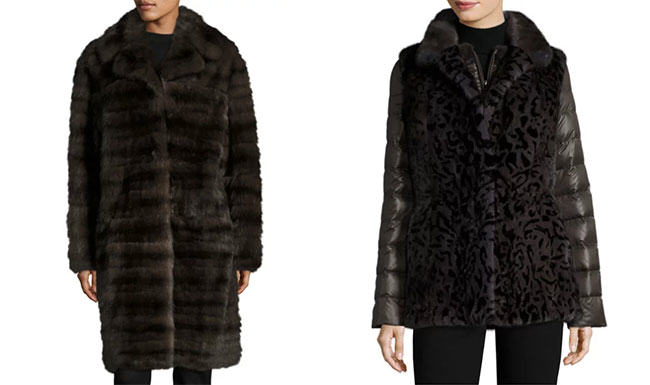
Defined as “A popular or the latest style of clothing, hair, decoration, or behavior” (Oxford Dictionary), fashion is constantly changing. When someone buys something to be fashionable, it is usually an item of clothing – or an accessory – whose life-cycle as a fashionable product is relatively short. That print, silhouette, or shape that is considered fashionable today is probably not going to be so next season or next year. On the other hand, classic clothing could be considered as wardrobe staples that do not follow trends and can be worn for many years. Would you not consider fur to fit into the latter? Fur coats are made to last and while some may be considered fashionable, nearly all are designed to have some degree of longevity.
Modesty and Protection
Let’s consider the purpose of clothing. We wear clothing for a lot of reasons, sometimes it is for fashion, other times status, or for identification purposes (a uniform, for example). But the majority of us wear clothing primarily for modesty and for protection from the elements.
Fur plays a huge role in protecting us from the elements. The majority of human beings live in climates where it is necessary to wear clothing throughout the year to protect ourselves from the sun, rain, wind, and cold. We have many options when the weather turns cold, and we have discussed the unintended consequences of wearing synthetics here.
But it goes without saying that we need to wear something.
If you are feeling the urge to buy and wear something fashionable, you probably don’t think “fur!” A new dress, a pretty pair of shoes, or an interesting accessory usually come to mind when I think about wearing something fashionable. And funnily enough, people don’t complain about cows being killed “for fashion” because they are made into lovely shoes. Right? Or that sheep are being raised on farms “for fashion". Not really. They just go out and buy that new wool sweater.
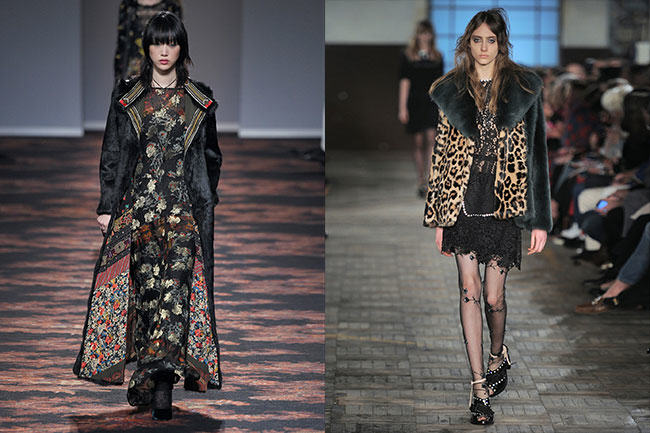
But if you were in the mood to make a fashion statement, would you really choose an expensive garment you can only wear for four months in the year, that requires expensive storage and cleaning, and takes up a lot of closet real estate? No, most would choose a pair of earrings instead.
Yet some people claim it is wrong to wear fur because it is just for fashion. I don’t think fur is for fashion, it is for keeping warm. It is a beautiful, stylish way to keep warm, but there’s a reason why you don’t see a lot of mink coats on the streets in July. That’s because fur is worn as protection from the elements. In public opinion research conducted by the Fur Council of Canada, the majority of women who wore fur said that it was primarily for warmth.
Canada Goose Irony
I find it ironic that one of the brands that gets the most flack for killing animals “for fashion” is Canada Goose. Canada Goose is not a fur brand but it trims its parka hoods with coyote fur because it considers it to be the best material to protect your face from wind and cold. I have a Canada Goose parka, and I love fashion, and I can tell you right now that my least fashionable coat is probably my Canada Goose parka. Look at the silhouettes, the colour palette, the finishings. These coats aren’t fashionable, they have Velcro on them! Velcro! Probably the antithesis of fashion.
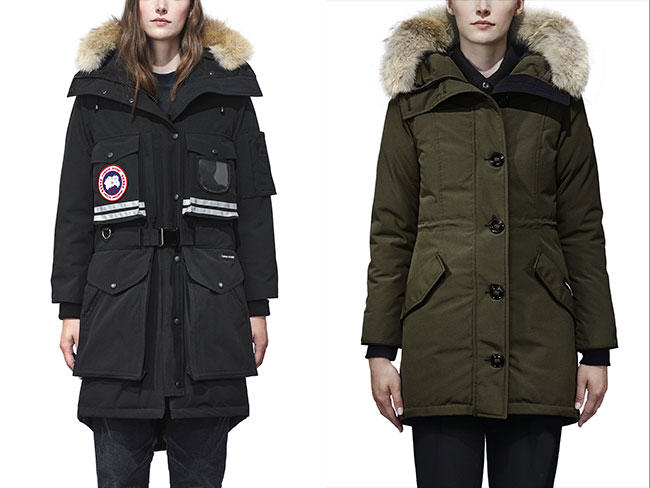
They might not be fashionable, but do you know what Canada Goose coats are? WARM. Practical. Reliable. Long-lasting. Made in Canada. Did I mention warm? That’s why people buy them and that’s why the company has done so well. Sure, it has great branding and it knows how to market its product, but the brand wouldn't have done well if its coats couldn’t stand up to the harshest winters. The majority of people don’t buy Canada Goose parkas as fashion statements, they buy them to keep warm. And you don’t need to live in the Arctic to need to keep warm. Try standing still at a bus stop or in a dog park for 20 minutes in the middle of a cold winter. If you’ve done it wearing Canada Goose, you’ll understand how fantastic these parkas are.
The same applies to many fur coats. Sure, there are some that are fashionable. But they are mostly being worn in fall/winter. Sure fur is soft and stylish and pretty ... but first and foremost, it is warm.
Practical AND Stylish
And don’t even try to argue that if fur coats are primarily practical, why are they designed with trends and fashion in mind? Good design is integral in every aspect of our lives, and just because we want to wear fur because it is warm, doesn’t mean we don’t want to look good. It is absolutely acceptable to make a practical garment and also consider what it will look like, from a fashion perspective. When you are paying that much for a garment, you want it to be as stylish as possible, which is why fur coats and jackets tend to be cut to be flattering and fashionable, as well as being practical. But there is no denying that their primary function is as a winter clothing garment.
People have many reasons to argue about fur, and you are free to choose not to wear it. But stop saying that it is wrong to use fur because it is "only for fashion". It's only people who don't wear fur who make this claim, Protection from the elements is not a question of fashion, it is a question of comfort and sometimes survival. You can choose to wear a synthetic coat made from petroleum by-products to keep you warm, you can wear a down-filled parka with a coyote-trimmed hood, you can wear a full-length mink coat, but whichever you choose, the primary reason for that purchase is not fashion, it is function. And fur is nature's best answer to winter, People who wear fur know this.
Have you ever wanted to buy vintage fur? If you’ve ever been to a secondhand store or an antiques market,…
Read More
Have you ever wanted to buy vintage fur? If you've ever been to a secondhand store or an antiques market, you'll know that there is a huge selection of beautiful furs available for sale. Whether you are an eco fashion warrior who tries to choose secondhand, or a new fur coat is out of budget for you, secondhand furs can be an excellent way to add newness (and warmth) to your winter wardrobe. If you choose to go vintage, then there are a few things you need to consider before making your purchase.
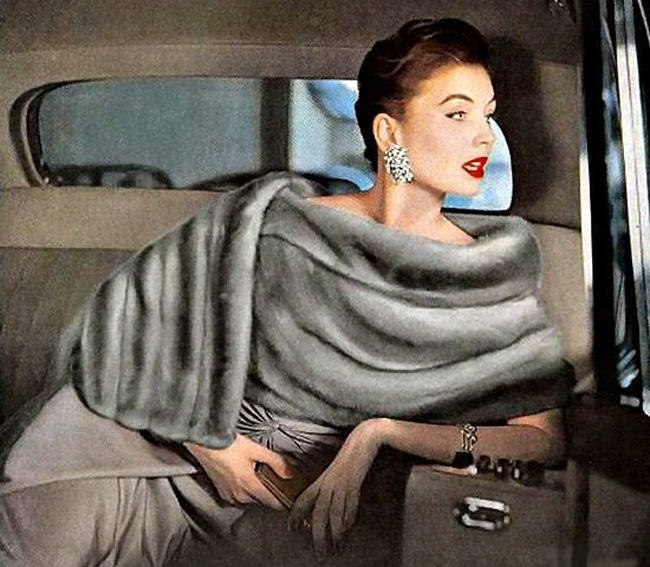
Here are our tips on avoiding moths, dry rot, and tears when shopping for your next piece of vintage fur.
• If the fur has a yellow tinge, then it means it is oxidized. The discolouration shouldn't turn you off buying a fur if it is a great piece, but it does affect the colour of the pelts. Look for the yellow tinge on the areas that are exposed to the sun, for example the shoulders, and the sleeves.
• If the fur and its leather have a brittle feel, then do not buy it. Fur and its leather should be soft and supple and skins that have dried out or have dry rot tend to be brittle and crunchy.
• Test the leather for dry rot by gently stretching the reverse (leather) side of the fur. (You can usually access this through the lining, and most are open.) The fur's leather should have some elasticity when you gently stretch it. If you don't feel any elasticity, then don't buy this fur because dried-out, brittle leather is more likely to tear or fall apart.
• Check for rips. They can be a sign of bad wear and tear, or again, of dry rot. If there are several rips in the coat, chances are the fur is dried out. Check areas like the arm holes, shoulders, and neckline for rips.
• Is the fur shedding a lot? This could be a sign of moths. Keep in mind that some delicate furs can break (for example rabbit or chinchilla) and most furs shed a little bit, but if there are a lot of hairs coming off the garment, or the hairs are coming out in clumps, then do not buy the coat.
Now that you know the tips and tricks to buying vintage fur, it is time to go shopping!
5 Reasons Why We Must Wear Leather and Fur
by Truth About Fur, voice of the North American fur tradeThe world is changing and, with it, our approach to consumption. As the impact of global warming worsens, many consumers…
Read More
The world is changing and, with it, our approach to consumption. As the impact of global warming worsens, many consumers are rethinking what they buy, and how much of it. "Local", "organic" and "minimalism" are all buzzwords many of us are drawn to, and some people question the need to eat animals, or wear leather and fur. Where does that leave us with animal use?
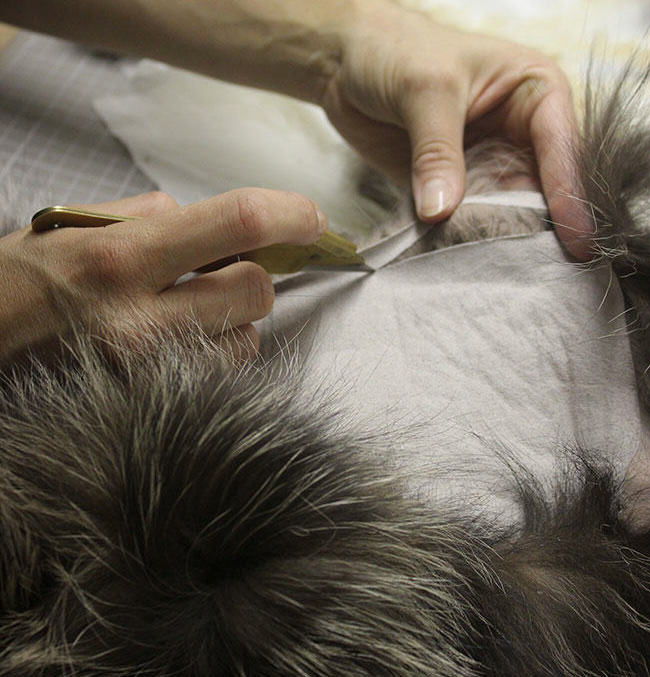
The use of animals is an ethical dilemma that many people question, but most people agree that if animals are well-treated, they are not in danger of becoming extinct, none of the animal is wasted, and the animal is put to good use, then it is acceptable for us to use and consume them.
SEE ALSO: WHY FUR IS THE ETHICAL CLOTHING CHOICE
Animal use is an integral part of many people’s lives, and is linked to essential products in our everyday life, such as medication, food, and clothing. Animals are used in medical testing in order to find cures to life-threatening diseases. We eat animals and while some people question the need to do this, there is plenty of evidence it can be done without harm to our planet. In fact, lots of land is better suited for pasture than for cultivation. And remember that animal manure is used to replenish the soil to grow crops. But if we are concerned about possible impacts, a small reduction in the amount of meat we consume – and waste – can go a long way. And lastly, we wear many types of animal products in order to protect ourselves from the elements. Fashion may not be essential, but clothing is. The need to keep warm in cold weather is a matter of life and death.
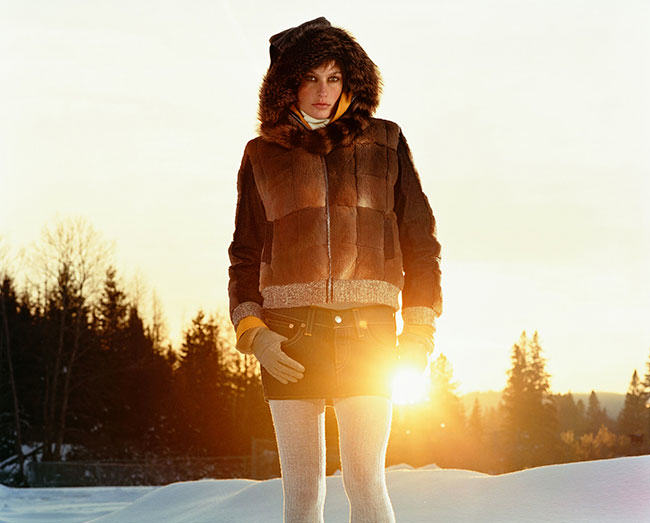
If you live in a cold country, you’ll need clothing that can protect you from the elements, and your choices should involve leather, fur, and other animal products. Why? Because there are no viable alternatives.
If we really care about the environment (and we all should because nothing else matters if we don't have water and food and clean air), we will want to buy sustainable fashion products that use production processes that are not too harmful to the environment, that are long-lasting, and that are biodegradable. That is exactly what animal skins are. Yes, they aren’t perfect; leathers and furs use chemicals in their processing and finishing (like all other textiles), and sometimes the farming has an environmental impact. But when you consider how long a good fur coat or high-quality leather bag lasts, you’ll realize that the environmental damage is minimal compared to the lifespan of the item.
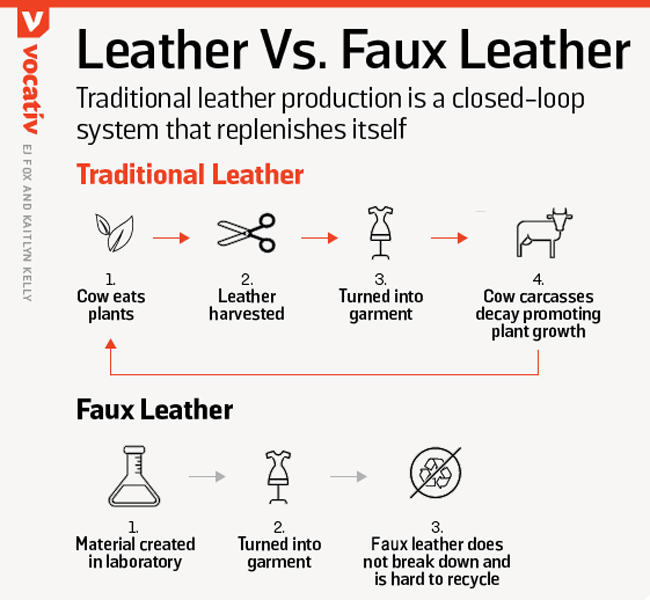
So here they are, the five reasons why we must all wear leather and fur, and these reasons all point to the fact that there are simply no viable alternatives.
1. There are no alternatives that are biodegradable. The synthetic alternatives to fur and leather take much longer to biodegrade (50 years for treated leather vs. 500+ years for pleather), and even when they have “biodegraded”, there are still remains of the plastic particles in the soil, which we are now finding in our oceans and inside fish. Truth About Fur is in the process of conducting an experiment to prove that real fur biodegrades much faster than “faux”, and the results are more dramatic than even we expected.
2. There are no alternatives that are sustainable. Synthetics are made from petroleum by-products. You probably know that petroleum is not a renewable resource. The problems caused by the extraction and transport of petroleum are only a part of the issue, let’s not get started on the political issues (read: wars) that are caused by petroleum. Animals are a renewable, sustainable resource. (Actually, wool, down, and cashmere and other similar materials are sustainable, so these are certainly viable alternatives when it comes to winter coats. But the animal rights activists are against those, too, since they come from animals. Usually a sensible winter wardrobe would combine fur, leather, down, wool, and cashmere – you’ll never be cold.)
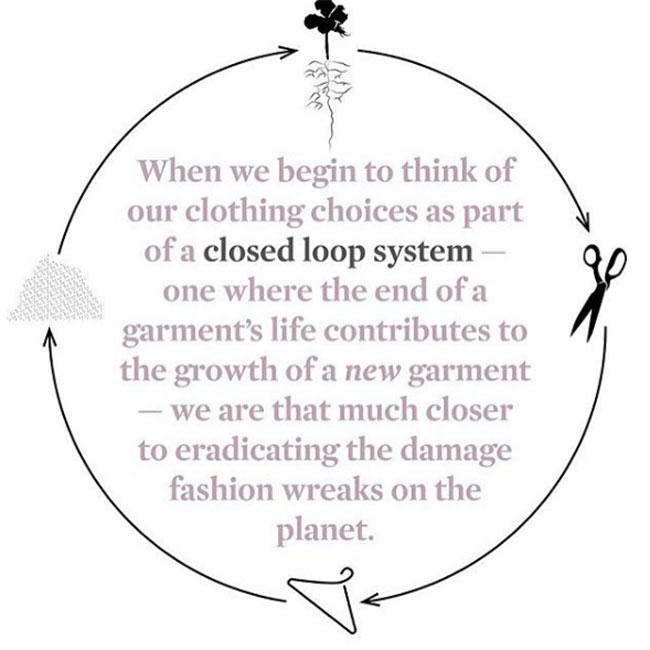
3. There are no alternatives that are as long-lasting. While a fake fur or leather jacket may be sitting in a landfill for a few hundred years longer than its real counterpart, that doesn't mean it is longer lasting in a fashion perspective. When well cared for, fur and leather items can last for decades, but fake leather and fur hardly do the same. Both look worn out much faster (and not in a cool way – like worn out leather), and they also don't maintain their warmth or waterproof qualities. You don’t find many fake leather bags being handed down from one generation to the next, do you?
4. There are no alternatives that are as environment-friendly. The points above do a good job of making this argument, but we can add to this by talking about the processing. Yes, leather and fur require chemicals for processing (leather requiring more than fur as you need to remove the hairs from leather, whereas with fur you are aiming to protect them). But two important things to consider here are that (1) the chemicals used to “dress” furs are really quite benign, e.g., alum salts (which are sold in the pharmacy to add to your bath water for sore muscles), and (2), the longevity of leather and fur items means that the chemicals per wear are much less than a synthetic alternative. Your leather bag or fur coat may have used chemicals in its production, but the fact that it lasts you 30 years makes it a more environment-friendly option than the synthetic version, made from a non-renewable resource that requires chemicals in its processing, which then looks tatty after two seasons. Another important thing to consider is that no synthetic material looks good in its natural state, while fur is frequently used in its natural state (meaning its natural colours), reducing the need for bleaches and dyes.
5. There are no alternatives that are as safe. We’ve yet to fully understand the bodily harm coming from wearing synthetics, but there’s a great deal of research that shows that synthetic materials may contribute to health issues such as infertility, respiratory diseases, and cancer. Why take the risk when there are natural alternatives?
If you truly care about the planet and its inhabitants, you’ll make consumption decisions based on what’s best for us all. You might refuse to eat animals or watch them being used as entertainment, but it is impossible to deny that synthetic clothing is causing irreparable harm to our planet. Choose materials that are sustainable, long-lasting, and biodegradable. Choose fur and leather because there are no viable alternatives.
***
To learn more about donating to Truth About Fur, click here.
